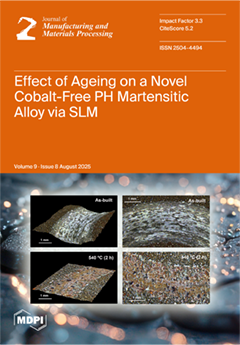Helical milling presents a promising alternative to conventional drilling for hole production, offering superior surface quality and improved production efficiency. While this technique has been extensively applied in the aerospace industry, its potential for machining common engineering materials, such as AISI 1045 steel,
[...] Read more.
Helical milling presents a promising alternative to conventional drilling for hole production, offering superior surface quality and improved production efficiency. While this technique has been extensively applied in the aerospace industry, its potential for machining common engineering materials, such as AISI 1045 steel, remains underexplored in the literature. This study addresses this gap by systematically evaluating the influence of key process parameters—cutting speed (V
c), axial depth of cut (a
p), and tool diameter (D
t)—on hole quality attributes, including surface roughness, burr formation, and nominal diameter accuracy. A full factorial experimental design (2
3) was employed, coupled with analysis of variance (ANOVA), to quantify the effects and interactions of these parameters. The results reveal that, with a higher V
c, it is possible to reduce surface roughness (R
a) by 30% to 40%, while an increased a
p leads to a 50% increase in R
a. Additionally, D
t emerged as the most critical factor for nominal diameter accuracy, reducing geometrical errors by 1% with a larger D
t. Burr formation was predominantly observed at the lower end of the hole, highlighting challenges specific to this technique. These findings provide valuable insights into optimizing helical milling for low-carbon steels, offering a foundation for broader industrial adoption and further research.
Full article





